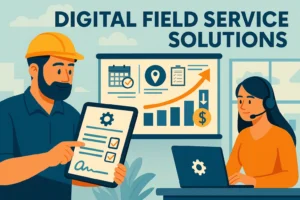Busy days don’t always equate to productive days. Crews can hustle for ten hours and still miss opportunities, accidentally extend travel time, or forget to log job notes. Field Service Time Tracking remedies that. It turns “I think” into “we know”—when a job started, who was on site, how long the work took, and whether the schedule was realistic in the first instance. With clear records, arguments fade, billing is faster, and managers coach based on facts, not intuition.
You don’t need a six-month overhaul. Start small: one crew, one KPI, one straightforward workflow for tracking. Shifton allows you to try the core toolkit for a month at no cost, so you can demonstrate impact on live jobs before you commit.
Field Service Time Tracking gaps: mobile, GPS, approvals
Costs are up, customer patience is short, and work combines scheduled visits with last-minute emergencies. Without a reliable trail of when and where time was spent, you end up guessing on payroll, overtime, and warranties. Field Service Time Tracking gives you verified punches tied to real locations and jobs. It also highlights poor planning—routes that zigzag, windows that are too tight, jobs that always overrun—so you fix the system, not just the people.
Here’s the point: tracking isn’t about policing. It’s about giving technicians cover when they did everything right, and providing managers with the data to eliminate friction the next time.
What “good” tracking looks like in the field
Field Service Time Tracking checklist: KPIs, exports, integrations
Arrive → auto-prompt. The app detects the geofence and nudges the technician to start time on the work order.
Do the work → record proof. Notes, photos, checklists, and part scans attach to the same job.
Wrap up → sign-off. Customer signature and finish time stamp the record.
Move on → route continues. The next stop and ETA update, and the clock resets.
Repeat that loop all day. The result is a timeline that explains every hour without back-office chasing.
What the platform must handle
Offline mode that actually works. Tunnels, basements, rural sites—no signal is normal. Punches, photos, and checklists should sync later without duplicates.
GPS + geofencing with guardrails. Enough precision to confirm presence on site, with privacy rules (no after-hours tracking, no map stalking).
Work-order integrity. Start/stop only on a specific job to avoid orphan punches.
Route awareness. Track travel minutes separately from on-site work to see where the day really went.
SLA context. Flag when a punch would break a window and suggest a rescue move. That’s where Field Service Time Tracking pays twice: fewer misses and cleaner records.
Where the minutes really go (and how to get them back)
Travel time. If half the “workday” is driving, you don’t have a timekeeping problem; you have a routing problem. Time data paired with routes shows which zones always run hot and which windows are unrealistic. Tighten territories, chain jobs better, and watch overtime drop.
Prep time. Ten minutes hunting parts at each stop equates to an hour lost by mid-afternoon. Track short “pre-job” segments and attach a parts checklist. You’ll see which job types need better kitting.
On-site time. If a task consistently runs long, fix the estimate or assign higher-level skills. Field Service Time Tracking turns “this always takes longer” from a complaint into a chart that forces a smarter plan.
Admin time. End-of-day note-typing is where details die. Capture notes as you go—voice-to-text, photo annotations, quick templates. Short, structured entries beat long novels written at 7 p.m.
Features that actually move the needle
One-tap start/stop with job lock. Prevents stray time that isn’t attached to a work order.
Geofenced punches. Optional guardrails that confirm presence without being intrusive.
Break compliance. Count paid vs. unpaid breaks automatically so payroll isn’t guessing.
Parts + time in one place. When a repeat visit happens, you’ll know whether it was missing stock, bad estimate, or skill mismatch.
Customer-visible proof. A clean service report with times, steps, and photos ends most disputes in one email.
Dashboards for action. Travel minutes per job, average on-site time by task, and overtime by crew. Field Service Time Tracking makes these numbers impossible to ignore.
Rollout plan your crew will actually follow
Choose one KPI. Example: cut travel minutes per job by 15% in four weeks.
Limit options. Use one template for arrivals, one for wrap-up notes, one report style.
Set fair rules. No tracking off the clock; no GPS pings when the app is closed. Explain the “why” before the “how.”
Pilot with three champions. Let respected technicians test first and suggest tweaks.
Coach with data, not tone. Review one route per technician each week; praise good records before flagging gaps.
Upgrade estimates. Use real task times to fix job durations and SLA windows.
Scale. Roll to the next crew only after the first crew achieves consistency.
What to track weekly (and what “good” looks like)
Travel minutes per job. Trending down 10–20% after a month means routing and zoning are improving.
On-site time per task type. Narrowing variance means estimates are becoming more accurate.
First-time fix rate. Rising 3–7 points indicates parts/skills matching is working.
Overtime hours. A steady drop is the clearest signal that time tracking is changing behaviour.
Punch completeness. Over 95% of jobs with clean start/finish, notes, and at least one photo is a solid target.
Privacy and trust
Strong time tracking doesn’t require intrusive tracking. Keep it simple: track within geofences during jobs, show technicians the exact data you store, and let them correct obvious mistakes. When people see Field Service Time Tracking protecting their time and reputation, adoption takes root.
How time data powers the rest of operations
Scheduling. Real task times make tomorrow’s plan believable.
Routing. Identify zones that should start later or earlier to avoid traffic.
Inventory. Tie long visits to missing parts and fix the kitting list.
Billing. Faster invoices with fewer disputes.
Coaching. Identify who excels at specific job types and emulate their checklists.
Why Shifton is a practical choice
Shifton was developed for field work: offline punches, geofencing guardrails, job-locked timers, and simple reports customers actually read. It also connects time to routes, skills, and parts, so you see cause and effect, not just time. Set up a workspace in minutes, invite one crew, and test a clean loop for a month—no cost while you demonstrate the benefits on your own routes.
Start here: Registration • See it live: Book a Demo • Explore the stack: Field Service Management
Objections you’ll hear—and straight answers
“We already track hours in payroll.” That’s end-of-day totals, not route-aware job time. You can’t fix zones, parts, or estimates with a single number. Field Service Time Tracking provides context.
“GPS feels invasive.” Use geofences and on-job tracking only. No off-the-clock data, period. Show the timeline to technicians; let them correct mistakes.
“It’ll slow us down.” One-tap punches and voice notes take seconds and save hours of back-and-forth later.
FAQ
Does Field Service Time Tracking work without a signal?
Yes.
A robust app caches punches, photos, and notes offline, then syncs once service returns—no duplicates, no lost time.
Will this reduce technician flexibility?
No.
Track within job geofences and keep swap/approval flows. People can still trade visits; the system just maintains coverage and windows intact.
How soon will we see results?
Two to four weeks.
Once punches are consistent and routes are refined, travel time decreases, estimates become realistic, and disputes diminish. Field Service Time Tracking accelerates each step.
Do we need IT to deploy?
Not much.
Import crews and jobs via CSV, set zones and geofences, and start the pilot. Integrations can follow once you’ve demonstrated the uplift.
How do we prove ROI?
Track four numbers.
Travel minutes per job, on-site time by task, first-time fix rate, and overtime hours. If each trends the right way, finance won’t need a long presentation. Ready to move from guesses to clear facts? Run a pilot with one crew, one KPI, and clear rules. The basic plan is free for the first month, so your only risk is remaining with arguments and slow billing.

 English (US)
English (US)  English (GB)
English (GB)  English (CA)
English (CA)  English (AU)
English (AU)  English (NZ)
English (NZ)  English (ZA)
English (ZA)  Español (ES)
Español (ES)  Español (MX)
Español (MX)  Español (AR)
Español (AR)  Português (BR)
Português (BR)  Português (PT)
Português (PT)  Deutsch (DE)
Deutsch (DE)  Deutsch (AT)
Deutsch (AT)  Français (FR)
Français (FR)  Français (BE)
Français (BE)  Français (CA)
Français (CA)  Italiano
Italiano  日本語
日本語  中文
中文  हिन्दी
हिन्दी  עברית
עברית  العربية
العربية  한국어
한국어  Nederlands
Nederlands  Polski
Polski  Türkçe
Türkçe  Українська
Українська  Русский
Русский  Magyar
Magyar  Română
Română  Čeština
Čeština  Български
Български  Ελληνικά
Ελληνικά  Svenska
Svenska  Dansk
Dansk  Norsk
Norsk  Suomi
Suomi  Bahasa
Bahasa  Tiếng Việt
Tiếng Việt  Tagalog
Tagalog  ไทย
ไทย  Latviešu
Latviešu  Lietuvių
Lietuvių  Eesti
Eesti  Slovenčina
Slovenčina  Slovenščina
Slovenščina  Hrvatski
Hrvatski  Македонски
Македонски  Қазақ
Қазақ  Azərbaycan
Azərbaycan  বাংলা
বাংলা 
